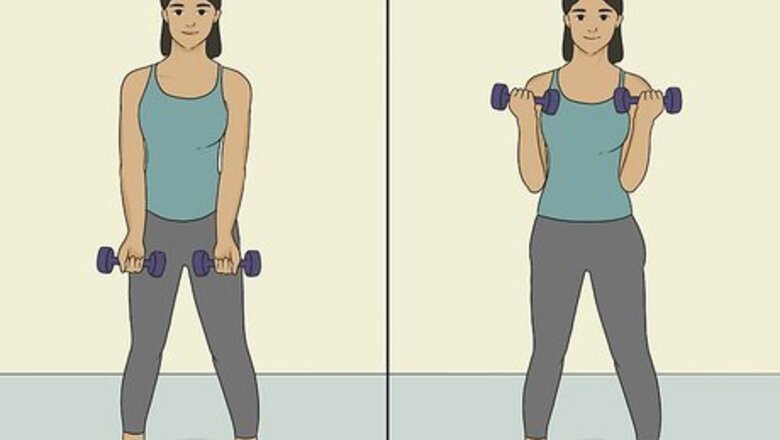
views
Doing Bicep Exercises
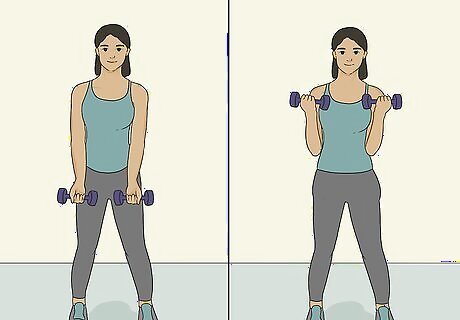
Begin with bicep curls. Your biceps are your strongest arm muscles and when they become more defined, they create a nice curve just above your elbows. Use free weights, also called dumbbells, that are comfortable for you to hold in each hand and provide just enough weight to be challenging but not impossible to lift. Bicep curls can be done in a standing position on even ground or seated on a workout bench.Note: You can also do alternating bicep curls as a variation on standard bicep curls, six times per arm, alternating each arm. Stand with your legs shoulder distance apart and a dumbbell in each hand on either side of your body, with your palms facing each other. The dumbbells should be horizontal in each hand. Breathe out and raise the dumbbells until they reach the height of your shoulder. Pause and then breathe in as you lower them back down. Do not jerk your upper body as you lift the weights. You want smooth, fluid movements, with a full contraction as you move your arm up and a full stretch as you move your arm back down. Repeat these movements for three to four sets of 12 reps.
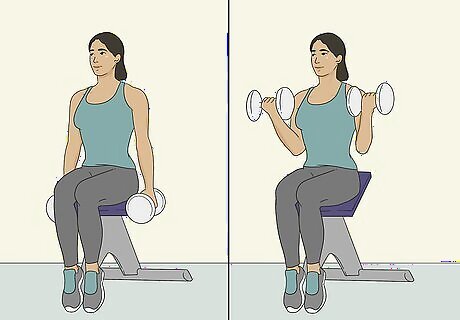
Practice inner bicep curls. You are targeting your inner bicep muscles with this exercise. You can do these exercises standing or seated. If you do the seated version, sit on the end of a work out bench and keep your abdominal muscles tight as you raise and lower the dumbbells. Hold one dumbbell in each hand with your palms facing each other. Breathe out and raise both dumbbells so they are on either side of your body at shoulder height. The dumbbells should be horizontal in your hands as you raise them. Pause and then breathe in as you slowly lower them down. Repeat these movements for three to four sets of 12 reps.
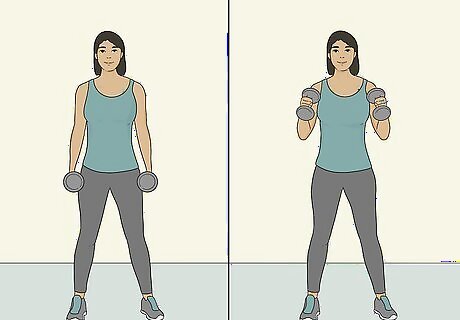
Try hammer curls. These exercises are great for building your bicep muscles and can be challenging if you increase the reps over time. Start in a standing position with your legs shoulder distance apart. Hold one dumbbell in each hand along the sides of your body with your palms facing your body. Raise both dumbbells by curling your forearms towards your body. The dumbbells should be vertical in your hands. Keep your upper arms straight and even. Pause and then lower them back down. Repeat these movements for three to four sets of 12 reps.
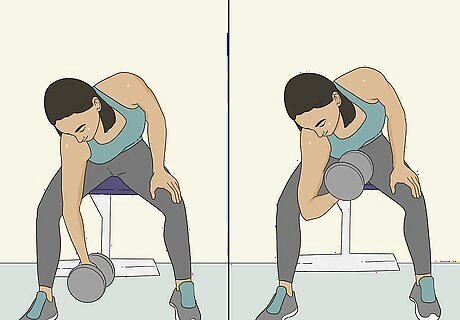
Do seated isolated dumbbell curls. It’s best to do these exercises in a seated position so you can focus on working your bicep muscles. Sit at one end of a work out bench with your legs shoulder width apart. Hold one dumbbell in your hand and place your elbow extended against the front area of your inner thigh. You should have enough room between your legs to raise and lower the dumbbell against your inner thigh without hitting your other leg. Breathe out and raise the dumbbell until it reaches shoulder height. Pause and breathe in as you extend your arm back to the starting position. Repeat this movement six times on each arm for three to four reps.
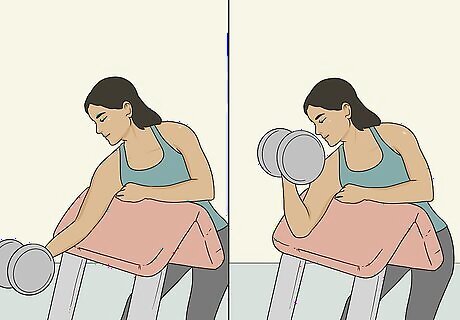
Practice Preacher bicep curls. To do these exercises you will need access to an arm pad that you can raise and lower according to your height. Start with Preacher bicep curls using a supination grip, where your palms are facing up. Place your upper arms against the arm pad so your palms are facing up, with a dumbbell in each hand. Breathe out and raise one dumbbell until your forearm is parallel to the floor, pause, and then breathe in as you lower your arm back down. Repeat these movements with your other arm. Alternate on each arm, six times each arm, for three to four sets. Michael Matthews Michael Matthews, Fitness Coach Progressive overload is key for bicep growth. Focus on adding more weight, reps, and sets to curls over time. Barbell and dumbbell variations performed with full range of motion and peak contractions will maximize tension and build impressive mass.
Doing Tricep Exercises
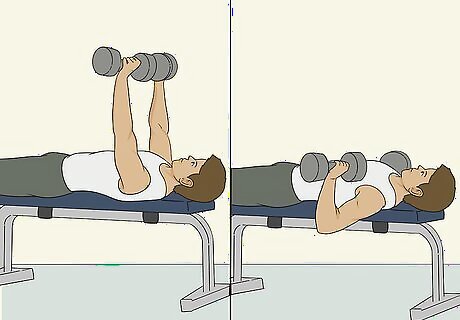
Do tricep extensions. Strengthen your triceps by doing extensions with a dumbbell on your back, lying down. This will allow you to target your tricep muscles in a comfortable and stable position. You will need access to an exercise bench to do this exercise.Note: You can also do overhead tricep extensions, which are done standing. Hold one dumbbell between both hands over your head. Breathe in as you bend your elbows and lower the dumbbell behind your head, pause, and then breathe out as you straighten your arms back to the starting position. Lie down on your back on a bench with your legs on either side of the bench. Hold one dumbbell with both hands so it is directly over your chest. Breathe in as you bend your elbows and lower the dumbbell towards your forehead. Pause and then breathe out as you straighten your arms back into the starting position. Repeat these movements 12 times for three to four reps.
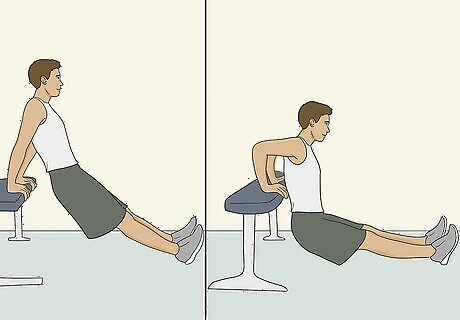
Try tricep dips. You can do tricep dips on an exercise bench or sitting in a chair. This exercise is ideal if you do not have access to free weights as it requires you to use your body weight. Sit on the edge of an exercise bench or on the edge of a chair, with your legs bent or extended in front of you. Place your hands on either side of your hips behind you on the bench or chair. Shift your hips forward so they are two to three feet from the bench and bend your elbows. Breathe in and lower your hips down towards the ground, bending at the elbows and creating a 90 degree angle with your arms. Pause and breathe out as you raise your hips back to the starting position. Repeat these movements 12 times for three to four reps.
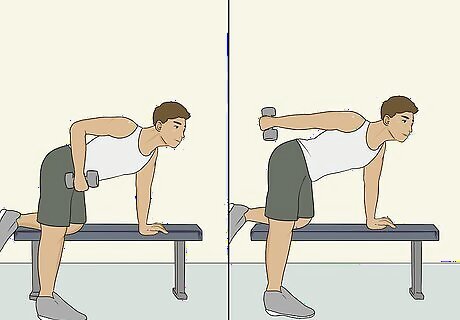
Practice tricep kick backs. This exercise will help to define your triceps, especially if you increase your reps over time. You will need an exercise bench to do this exercise. Start with your right leg bent on the exercise bench and your right arm flat on the bench. Keep your left leg straight on the side of the bench. Hold a dumbbell in your left hand. Keep your lower back straight as you bend forward at the hips so your torso is almost parallel to the floor. Your left arm should be bent so your arm forms a 90 degree angle and the dumbbell is parallel to the floor. Breathe out as you extend your left arm behind you, lifting the weight up and back. Pause and breathe in as you return your arm to the starting position. Be careful not to jerk your body as you lower the dumbbell back down. Repeat these movements six times on each arm for three to four reps.
Creating an Arm Workout Routine
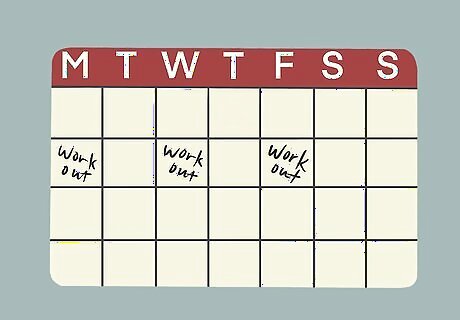
Plan to do your workout three times a week. When doing an exercise routine that involves weight lifting or resistance bands, you should allow your body 48 hours to recover. This means you should do your arm workout on alternating days (Mondays, Wednesdays, and Fridays, for example) so your muscles have a sufficient amount of time to rest. Your arm muscles are a small muscle group and can be easily injured if they are overworked. Prevent injuries or pain by always giving your muscles time to recover between sets and between workouts. Try to stick to the same three days schedule every week so you can commit to your workout routine and integrate it into your work schedule.
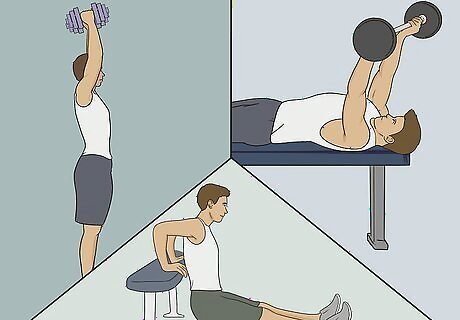
Vary your workout exercises. Muscle development plateaus when you complete the same routine each session. Avoid this by challenging your muscles with different exercises on different days or slight variations on existing exercises.Tip: Your body adapts to workouts around four weeks. Change your routine within four to six weeks to prevent your body from plateauing. You may want to create a schedule of exercises where you do different arm exercises each week and rotate the exercises so you are always varying your exercises from day to day or week to week.
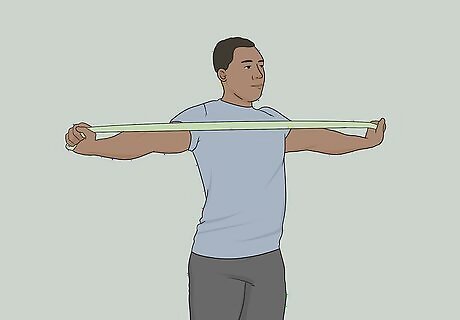
Use weights or resistance bands. Before you start doing arm exercises, you should buy free weights that are comfortable and challenging enough for your level of fitness. You can also use resistance bands in lieu of free weights if you are looking for a more portable and convenient training tool. If you have never used free weights before, you may want to ask an assistant at your gym for tips on how to lift weights properly. For these arm exercises, you will be doing at least three to five sets of each exercise, 10-20 times each time. You should look for an amount of weight that you are able to lift 10-20 times without experiencing muscle failure or extreme muscle fatigue. During your workout, muscle failure should occur right after you have done your last rep. The more you lift weights, the more familiar you will become with your muscle failure point. Depending on your current fitness level, you may begin with lighter weights, 5-10 pounds each, so you can build muscle strength over time.
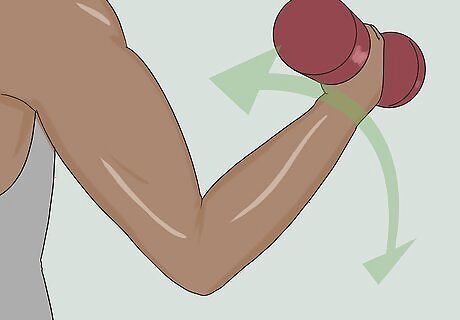
Do full contractions for every exercise. To maximize your workouts, you should try to complete a full contraction for every exercise. This means completing a full contraction at the top of the movement and a complete stretch at the bottom of the movement. You should move from the starting position of the exercise to the ending position of the exercise with full effort and a complete range of motion. It can help to begin by practicing these arm exercises in a full body mirror so you can watch your form and make sure you are always completing a full contraction for each movement. You should also try to squeeze or flex your arm muscles between sets to keep your muscles active and to always stretch between sets to maintain your range of motion and prevent your muscles from cramping up.
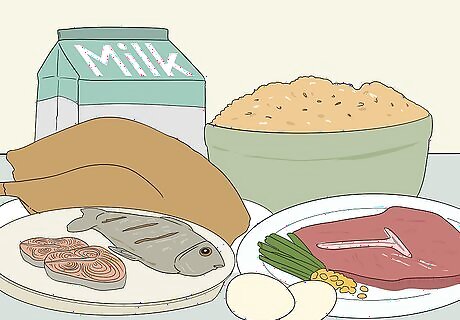
Maintain a healthy diet as you work out. A big part of building muscle effectively is maintaining a healthy diet, before, after, and between workouts. It’s important that you eat properly after your work out to maximize your muscle definition and help your body replenish itself after a workout. You should plan your meals around your daily calorie intake requirements and make post-workout meals that are high in protein and carbohydrates. Avoid foods high in trans fat and empty calories after a workout, as these will not help your body recover and can reduce your body’s ability to stay healthy, fit, and toned. If you are trying to build muscle, you should eat a diet that will encourage your body to build muscle as you work out. Your diet should consist of 46 grams for women and 56 grams for men of protein (the amount of protein varies greatly on your weight, your goals and how active you are, most people only need to take in 0.37g per pound in bodyweight, athletes and the like would be having around 0.7g to 0.8g per pound of bodyweight), such as red meat, fish, poultry, eggs, and dairy. Focus on eating complete proteins, instead of incomplete proteins, particularly animal products and vegetarian sources of protein like beans, soy, quinoa, and chia seeds. Your diet should also include healthy sources of carbohydrates, such as brown rice, rolled oats, sweet potatoes, and whole rye bread. You should cook your foods in healthy fats like olive oil (olive oil should not be cooked with but rather used as a salad dressing sparingly, as exposing it to high temperatures changes it's structure and turns it into a bad type of fat) and sunflower oil, and consume plenty of fiber through vegetables and fruits.




















Comments
0 comment